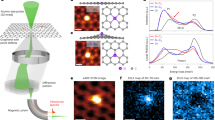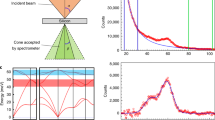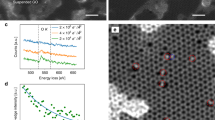Abstract
The spatial resolutions of even the most sensitive isotope analysis techniques based on light or ion probes are limited to a few hundred nanometres. Although vibrational spectroscopy using electron probes has achieved higher spatial resolution1,2,3, the detection of isotopes at the atomic level4 has been challenging so far. Here we show the unambiguous isotopic imaging of 12C carbon atoms embedded in 13C graphene and the monitoring of their self-diffusion via atomic-level vibrational spectroscopy. We first grow a domain of 12C carbon atoms in a pre-existing crack of 13C graphene, which is then annealed at 600 degrees Celsius for several hours. Using scanning transmission electron microscopy–electron energy loss spectroscopy, we obtain an isotope map that confirms the segregation of 12C atoms that diffused rapidly. The map also indicates that the graphene layer becomes isotopically homogeneous over 100-nanometre regions after 2 hours. Our results demonstrate the high mobility of carbon atoms during growth and annealing via self-diffusion. This imaging technique can provide a fundamental methodology for nanoisotope engineering and monitoring, which will aid in the creation of isotope labels and tracing at the nanoscale.
This is a preview of subscription content, access via your institution
Access options
Access Nature and 54 other Nature Portfolio journals
Get Nature+, our best-value online-access subscription
$29.99 / 30 days
cancel any time
Subscribe to this journal
Receive 51 print issues and online access
$199.00 per year
only $3.90 per issue
Buy this article
- Purchase on Springer Link
- Instant access to full article PDF
Prices may be subject to local taxes which are calculated during checkout




Similar content being viewed by others
Data availability
The datasets generated and/or analysed during this study are provided with the paper as source data. Source data are provided with this paper.
Code availability
Quantum ESPRESSO is an open-source suite of computational tools available at www.quantum-espresso.org.
References
Hage, F. S., Radtke, G., Kepaptsoglou, D. M., Lazzeri, M. & Ramasse, Q. M. Single-atom vibrational spectroscopy in the scanning transmission electron microscope. Science 367, 1124–1127 (2020).
Yan, X. et al. Single-defect phonons imaged by electron microscopy. Nature 589, 65–69 (2021).
Venkatraman, K., Levin, B. D. A., March, K., Rez, P. & Crozier, P. A. Vibrational spectroscopy at atomic resolution with electron impact scattering. Nat. Phys. 15, 1237–1241 (2019).
Hachtel, J. A. et al. Identification of site-specific isotopic labels by vibrational spectroscopy in the electron microscope. Science 363, 525–528 (2019).
Ong, S.-E. et al. Stable isotope labeling by amino acids in cell culture, SILAC, as a simple and accurate approach to expression proteomics. Mol. Cell. Proteomics 1, 376–386 (2002).
Li, X., Cai, W., Colombo, L. & Ruoff, R. S. Evolution of graphene growth on Ni and Cu by carbon isotope labeling. Nano Lett. 9, 4268–4272 (2009).
Li, Q. et al. Growth of adlayer graphene on Cu studied by carbon isotope labeling. Nano Lett. 13, 486–490 (2013).
Wiederhold, J. G. Metal stable isotope signatures as tracers in environmental geochemistry. Environ. Sci. Technol. 49, 2606–2624 (2015).
Krogh, T. E. A low-contamination method for hydrothermal decomposition of zircon and extraction of U and Pb for isotopic age determinations. Geochim. Cosmochim. Acta 87, 485–494 (1973).
Susi, T. et al. Isotope analysis in the transmission electron microscope. Nat. Commun. 7, 13040 (2016).
Krivanek, O. L. et al. Vibrational spectroscopy in the electron microscope. Nature 514, 209–212 (2014).
Senga, R. et al. Position and momentum mapping of vibrations in graphene nanostructures. Nature 573, 247–250 (2019).
Zhang, H., Lee, G., Fonseca, A. F., Borders, T. L. & Cho, K. Isotope effect on the thermal conductivity of graphene. J. Nanomater. 2010, 537657 (2010).
Liu, Z. et al. In situ observation of step-edge in-plane growth of graphene in a STEM. Nat. Commun. 5, 4055 (2014).
Garvie, L. A. J., Craven, A. J. & Brydson, R. Use of electron-energy loss near-edge fine structure in the study of minerals. Am. Mineral. 79, 411–425 (1994).
Kimoto, K., Sekiguchi, T. & Aoyama, T. Chemical shift mapping of Si L and K edges using spatially resolved EELS and energy-filtering TEM. J. Electron Microsc. 46, 369–374 (1997).
Lichtert, S. & Verbeeck, J. Statistical consequences of applying a PCA noise filter on EELS spectrum images. Ultramicroscopy 125, 35–42 (2013).
Gan, Y., Sun, L. & Banhart, F. One- and two-dimensional diffusion of metal atoms in graphene. Small 4, 587–591 (2008).
Dienes, G. J. Mechanism for self-diffusion in graphite. J. Appl. Phys. 23, 1194–1200 (1952).
Banhart, F., Kotakoski, J. & Krasheninnikov, A. V. Structural defects in graphene. ACS Nano 5, 26–41 (2011).
Konečná, A., Iyikanat, F. & de Abajo, F. J. G. Atomic-scale vibrational mapping and isotope identification with electron beams. ACS Nano 15, 9890–9899 (2021).
Zan, R., Ramasse, Q. M., Bangert, U. & Novoselov, K. S. Graphene reknits its holes. Nano Lett. 12, 3936–3940 (2012).
Giannozzi, P. et al. Quantum ESPRESSO: a modular and open-source software project for quantum simulations of materials. J. Phys. Condens. Matter 21, 395502 (2009).
Acknowledgements
This work was supported by JST-PRESTO (JPMJPR2009), JST-CREST (JPMJCR20B1, JPMJCR1993), JSPS KAKENHI (16H06333, 21H05235), ER-C “MORE-TEM” and NEDO (JPNP16010) projects.
Author information
Authors and Affiliations
Contributions
R.S. and K.S. designed the experiments. R.S. performed the in situ graphene growth in TEM. R.S. and S.M. performed EEL spectroscopy. R.S. analysed the data. R.S., Y.-C.L. and R.K. prepared the samples on the TEM grid. R.K., T.Y. and M.H. prepared the samples by CVD. R.S. and K.S. co-wrote the paper. All authors commented on the manuscript.
Corresponding authors
Ethics declarations
Competing interests
The authors declare no competing interests.
Peer review
Peer review information
Nature thanks F. Javier Garcia de Abajo, Jordan Hachtel and Quentin Ramasse for their contribution to the peer review of this work.
Additional information
Publisher’s note Springer Nature remains neutral with regard to jurisdictional claims in published maps and institutional affiliations.
Extended data figures and tables
Extended Data Fig. 1 EEL spectra including zero-loss peaks at bright field and dark field.
a, EEL spectrum at bright field without samples. b, c, Linear- and log-scaled EEL spectra at dark field on 13C graphene. The natural width of the zero-loss peak in the ideal on-axis condition has been shown. As an instrumental function, the zero-loss half-width is 18 meV, whereas it is 45 meV in the off-axis condition (with sample). The zero-loss peak in the off-axis is an ambiguous concept and cannot be detected without a sample.
Extended Data Fig. 2 EEL vibrational spectra for 1 layer (1L) and 2 layers (2L) graphene made of 12C, 13C and both stacked 2L (12C/13C).
a, Comparison of the optical modes (H-peak) in the vibrational spectra of all the samples including 1L graphene shown in Fig. 1. The energy shift of approximately 7–8 meV between isotopes was found in 2L as in the case of 1L. The H-peak in 2L consists of two components due to possible contributions from the TO mode due to LO–TO splitting or the high-energy component of the LA mode. b, Line shape analysis of the vibration spectra obtained from 2L samples, where a rough component analysis by Voigt function is possible as in the case of 1L shown in Fig. 1. In this case, four components were used for the fittings: the L-peak, which is mainly the contribution of acoustic phonons, the two H-peaks mentioned above, and the peak that appears between them, which is considered to be the contribution of out-of-plane ZO mode.
Extended Data Fig. 3 Orientation dependence of vibrational spectra obtained by dark-field EELS.
The signal is almost identical regardless of the position of the EELS collection aperture (green, red and black); therefore, the in-plane orientation of graphene hardly affects the fitting parameters. The lattice defects in graphene also do not affect these parameters, except for the acoustic vibration mode in the lower peak, which is considered negligible.
Extended Data Fig. 4 Simulated phonon dispersion and PDOS.
The phonon dispersion (left) and PDOS (right) of 12C and 13C graphene obtained by DFPT calculations in Quantum Espresso. The energy difference between 12C and 13C graphene is 7.7 meV at the highest energy peak in PDOS corresponding to the LO mode and 6.7 meV at the second highest energy peak which is mainly contributed from the LO/TO mode. The interatomic force constants calculated from DFPT is, for instance, 52.4 eV Å−2 for the in-plane direction at Γ. This calculation was performed to estimate the energy shift of the PDOS of 12C and 13C with the simple model. To reproduce the experimental spectra, full calculation considering the charge modulation in the higher-order Brillouin Zone is necessary, although such calculation is beyond the scope of this study and is not addressed here.
Extended Data Fig. 5 Probe size and possible isotope configurations at the probed region.
a, Comparison of probe and pixel size with graphene lattice. When the electron beam is fixed on an atom with our probe condition in which the probe size is increased to gain the current, the resulting spectrum contains the signal of the nearest three atoms in addition to that of the atom at the centre of the probe. Thus, a single spectrum roughly consists of the average signal of four atoms. The momentum space was also integrated up to 3.5 Å–1. Therefore, the spatial resolution was influenced by the integration effect in both real and momentum space. Based on a study by Hage et al. using silicon single atoms on graphene, when the probe size is sufficiently small, a localized signal at the single atom level can be obtained in the dark-field EELS condition1. b, Isotope combinations of the four atoms. The colour distribution at the top in b corresponds to that used in Figs. 3, 4. The corresponding vibrational energies of the LO/TO mode at Γ are calculated by DFPT and shown on the bottom line in b. When all four atoms are 12C or 13C, the energy difference of the H-peak between them is the largest and detectable with more than 90% of confidence level. If any one or two of the four atoms belong to different isotopes, the peak positions are between them. In this case, there are six possible configurations, as shown in b.
Extended Data Fig. 6 Isotope colour maps before and after filtering.
a, b, The isotope colour map in Fig. 3 before and after median filtering, respectively.
Extended Data Fig. 7 Composition of residual gas in the TEM chamber measured by quadrupole mass spectroscopy.
The residual gases include hydrocarbons such as CHx and C2Hx.
Extended Data Fig. 8 Two-dimensional vibrational spectroscopy across a grain boundary.
a, TEM image of 13C graphene involving a grain boundary. The grain boundary extends from the top right to the bottom left of the image. The crystal orientation is rotated by approximately 16° across the grain boundary comprised of 5–7 membered rings, as indicated by the yellow lines. b, Annular dark-field image obtained by performing a STEM-EELS two-dimensional scan at the same position as in a. c, Colour map of the high-energy peak positions corresponding to b. d, The EEL spectra taken from positions 1–3 in b are shown. The H-peaks in all three spectra are almost identical.
Extended Data Fig. 9 H-peak position mapping on a crack of 12C graphene embedded by in-situ graphene growth in TEM.
a, b, TEM image of initial 12C graphene including a crack and the same position after the nanodomain growth, respectively. The newly grown domain contains prolific defects involving 5–7 membered rings, as shown in c. d, Annular dark-field image obtained by performing a STEM-EELS two-dimensional scan at the same position as in b. e, Colour map showing the position of the high-energy peak without noise filtering. The peak positions are almost uniform over the whole area, including the newly grown region.
Extended Data Fig. 10 Noise level quantifications of the measurements.
a, b, The variation of the measured vibrational peak positions for line scans with an exposure time of 1 s per pixel on 12C and 13C graphene, respectively. The standard deviations σ for 500 data points are 2.1 meV for 12C and 2.0 meV for 13C graphene, which is three times smaller than the energy shift S between 12C and 13C graphene ~8 meV. Because the standard deviations of the measured points are based on fitting and contain errors, then the confidence intervals cannot be directly measured around those data points. This statical analysis, however, simply proves the high detection level of 12C atoms in case of 4 atoms and will give a standard for future experiments. Note that the purities of these samples are both over 99%, and thus, the peaking data points may be attributed to 1% of the isotopes in the samples. c, The variation of the measured vibrational peak positions on 13C graphene (corresponding to Fig. 4a) shows a σ of 3.0 meV at an exposure time of 0.5 s. Note that the data points at the crack are excluded.
Source data
Rights and permissions
About this article
Cite this article
Senga, R., Lin, YC., Morishita, S. et al. Imaging of isotope diffusion using atomic-scale vibrational spectroscopy. Nature 603, 68–72 (2022). https://doi.org/10.1038/s41586-022-04405-w
Received:
Accepted:
Published:
Issue Date:
DOI: https://doi.org/10.1038/s41586-022-04405-w
This article is cited by
-
Single-atom vibrational spectroscopy with chemical-bonding sensitivity
Nature Materials (2023)
-
Phonon transition across an isotopic interface
Nature Communications (2023)
Comments
By submitting a comment you agree to abide by our Terms and Community Guidelines. If you find something abusive or that does not comply with our terms or guidelines please flag it as inappropriate.



